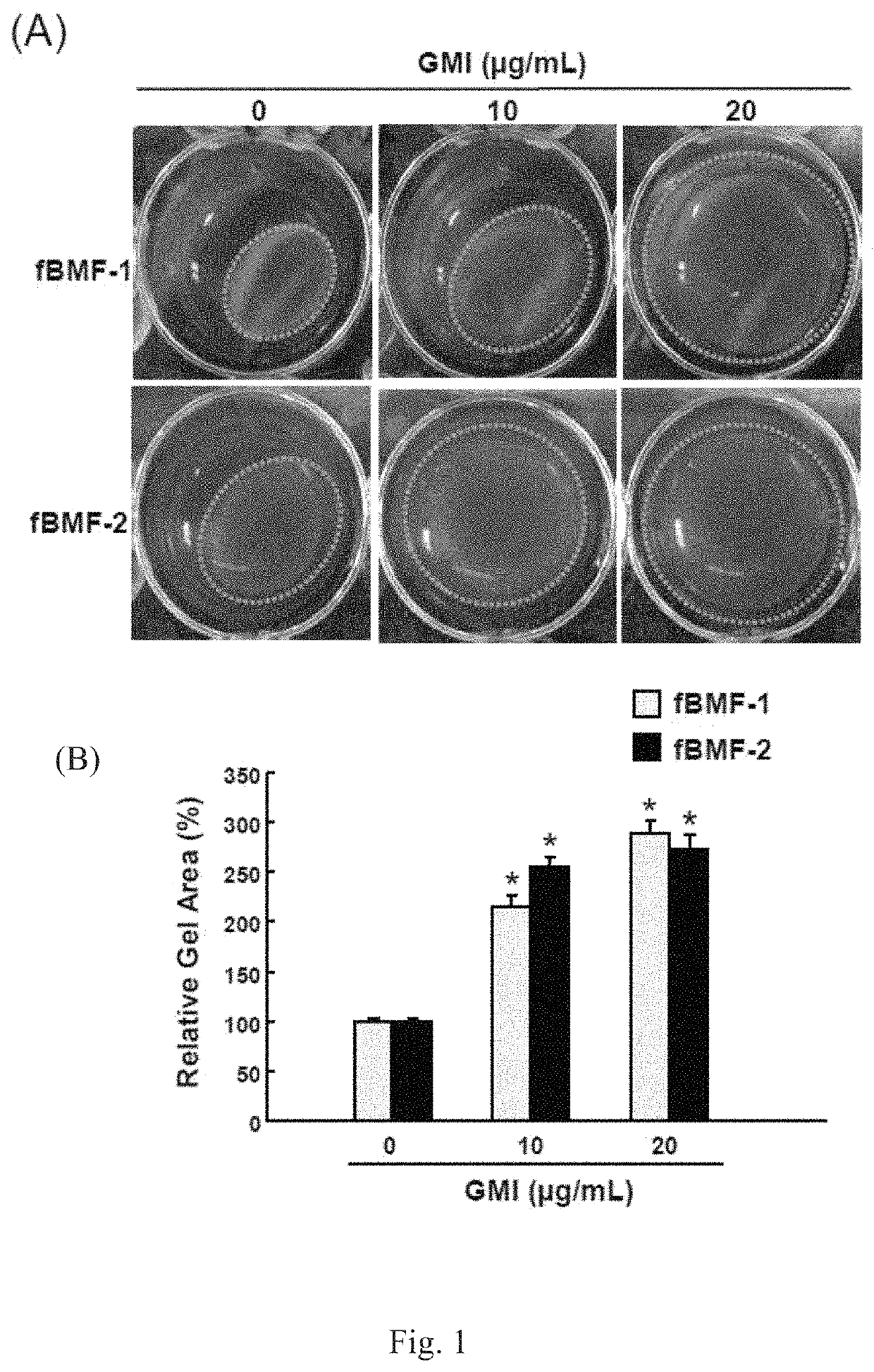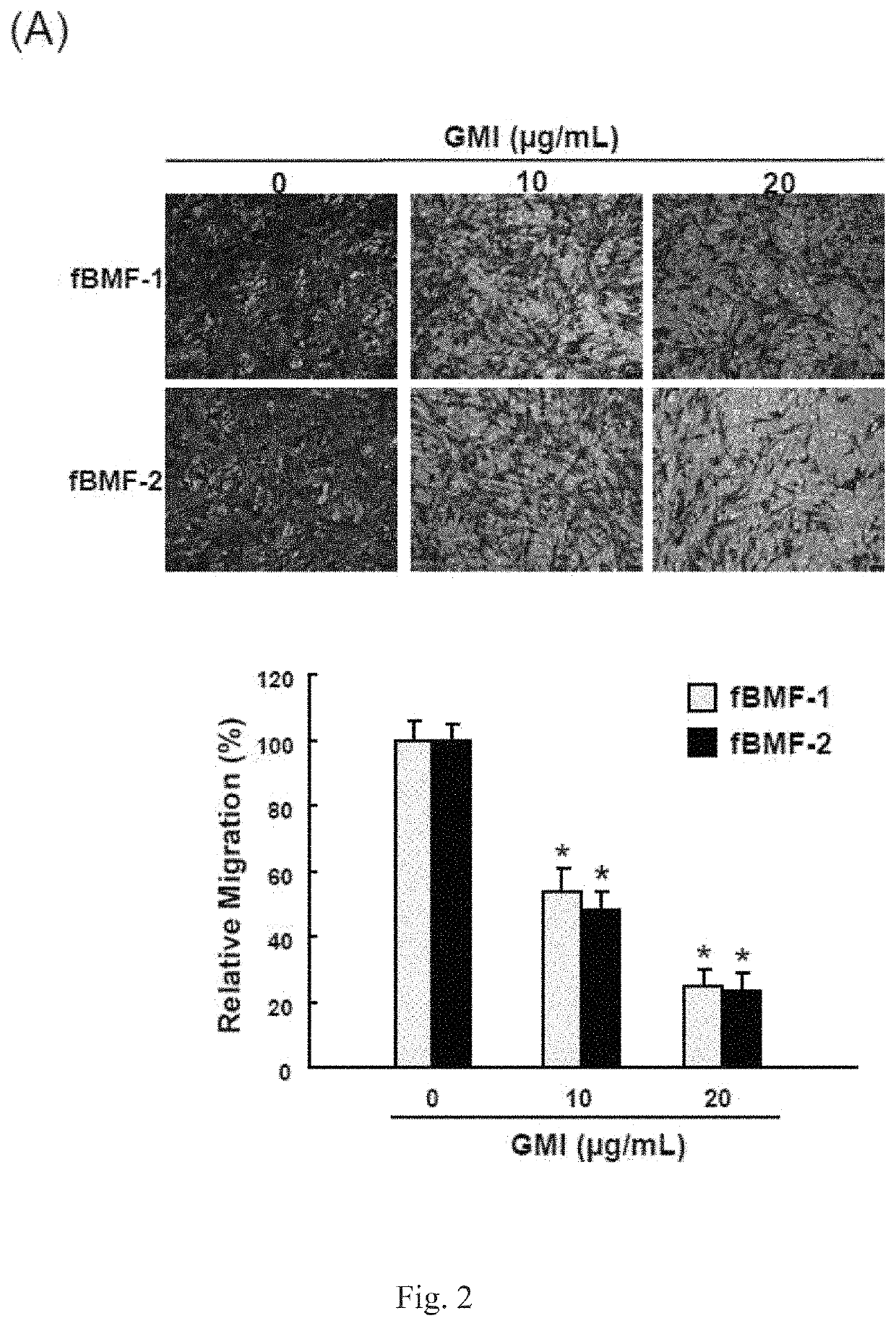Use of immunomodulatory protein from Ganoderma in inhibiting fibrosis
a technology of immunomodulatory protein and ganoderma, which is applied in the field of fibrosis disease, can solve the problems of organ failure, gradual decline of tissue and/or organ function, and destruction of original tissue structure, and achieve the effect of reducing the activity of myofibroblasts and reducing the expression level of interleukin (il)-6 and il-8
- Summary
- Abstract
- Description
- Claims
- Application Information
AI Technical Summary
Benefits of technology
Problems solved by technology
Method used
Image
Examples
example 1
GMI Reduces the Collagen Contractile and Wound Healing Abilities of fBMFs
[0054]Myofibroblasts are specialized contractile cells and responsible for wound closure. We found that GMI-treated fBMFs displayed a significant reduction of cell contraction capability at 10 μg / ml and 20 μg / ml (FIG. 1A). Moreover, the wound healing ability was markedly inhibited at both concentrations as compared to fBMFs cells without GMI treatment (FIG. 1B), indicating that GMI possess the potential to impede the cell migration of myofibroblasts.
example 2
GMI Downregulates the Migration and Invasion Abilities of fBMFs
[0055]To further evaluate the influence of GMI on the activated myofibroblast properties, fBMFs were treated with various concentration of GMI and cell migration and invasion abilities were examined using transwell system. As shown in FIG. 2A, we observed a dose-dependent effect of GMI on the migration capacity. Besides, our result demonstrated that invasion of myofibroblasts was reduced by 70% in the presence of 20 μg / ml GMI (FIG. 2B). In associated with the results from migration assay, we showed that GMI exhibited a significant anti-invasion capacity in myofibroblasts.
example 3
GMI Suppresses the Myofibroblast Activities in Arecoline-Stimulated BMFs
[0056]Our previous studies have demonstrated that arecoline, an alkaloid found in the areca nut, could induce myofibroblast transdifferentiation in BMFs, therefore, we sought to verify our findings using the arecoline-treated BMFs in the following tests. As expected, arecoline treatment induced the collagen contraction ability of BMFs whereas application of GMI significantly reversed this phenomenon (FIG. 3A). Also, GMI decreased the wound healing ability induced by arecoline in a dose-dependent fashion (FIG. 4B). In addition, the increased migration capacity was significantly blocked by GMI treatment (FIG. 4A). And the invasive phenotype of BMFs after arecoline stimulation was also inhibited by GMI (FIG. 4B).
PUM
| Property | Measurement | Unit |
|---|---|---|
| weight | aaaaa | aaaaa |
| bioactive properties | aaaaa | aaaaa |
| concentration | aaaaa | aaaaa |
Abstract
Description
Claims
Application Information
 Login to View More
Login to View More - R&D
- Intellectual Property
- Life Sciences
- Materials
- Tech Scout
- Unparalleled Data Quality
- Higher Quality Content
- 60% Fewer Hallucinations
Browse by: Latest US Patents, China's latest patents, Technical Efficacy Thesaurus, Application Domain, Technology Topic, Popular Technical Reports.
© 2025 PatSnap. All rights reserved.Legal|Privacy policy|Modern Slavery Act Transparency Statement|Sitemap|About US| Contact US: help@patsnap.com



